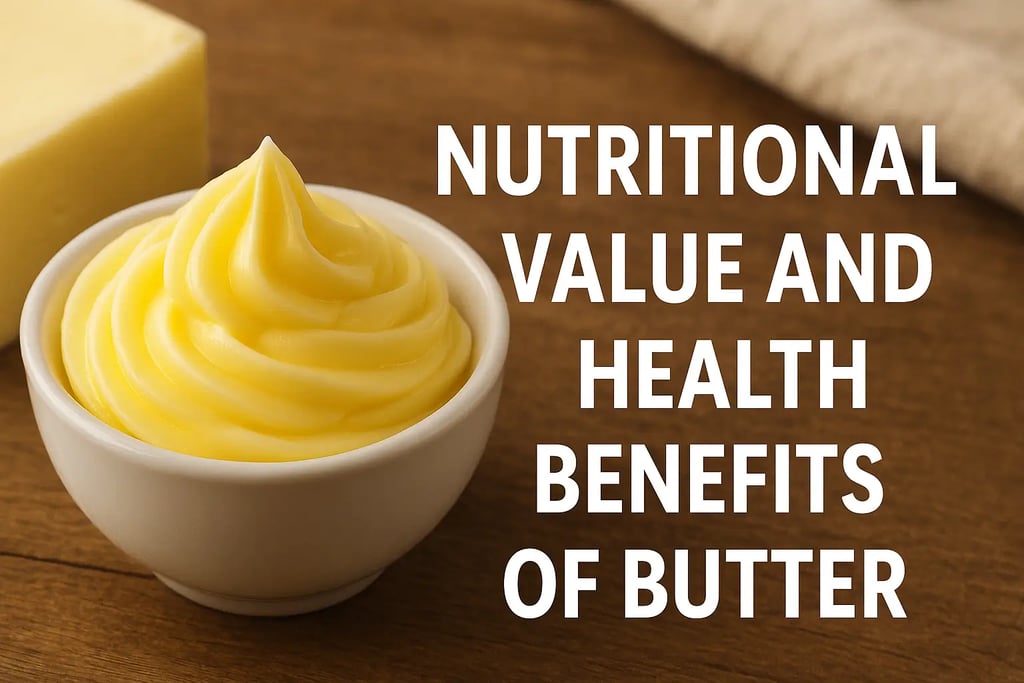Nutritional Value and Health Benefits of Butter | How to Use Butter in a Healthy Diet
Discover the nutritional composition and health benefits of butter. Learn how to incorporate butter into your diet wisely, its vitamins, fats, and healthy recipe ideas.


🧈 Nutritional Composition, Benefits, and Healthy Uses of Butter
Introduction
Butter is one of the most beloved dairy products worldwide — valued not only for its creamy texture and rich flavor but also for its nutritional composition. Understanding what butter contains and how it affects the body helps you make informed dietary choices. In moderation, butter can be a wholesome part of a balanced diet, providing essential vitamins, healthy fats, and energy.
🥛 Nutritional Composition of Butter
Butter is primarily made up of milk fat, which constitutes about 80% of its total content. The remaining portion includes water, milk proteins, and trace minerals. The types of fats in butter play different roles in supporting overall health.
1. Fat Content
Butter is rich in saturated fats, followed by monounsaturated fats and small amounts of polyunsaturated fats.
Saturated fats help in energy production and nutrient absorption.
Monounsaturated fats support heart health by improving cholesterol levels.
Butter also provides butyric acid, a short-chain fatty acid known to improve gut health and reduce inflammation.
2. Protein and Amino Acids
Although butter is not a major source of protein (only about 1–2%), it contains essential amino acids necessary for tissue repair and growth.
3. Vitamins in Butter
Butter is packed with fat-soluble vitamins that play vital roles in body functions:
Vitamin A: Enhances vision and supports immune health.
Vitamin D: Promotes calcium absorption and bone strength.
Vitamin E: Acts as an antioxidant, protecting cells from oxidative stress.
Vitamin K: Aids in blood clotting and bone metabolism.
4. Mineral Content
Butter also offers small amounts of calcium, phosphorus, and potassium, contributing to daily mineral intake.
5. Caloric Value
One tablespoon of butter provides around 100 calories, mostly from fat. Because of this, moderation is key — enjoying butter mindfully can balance taste and nutrition.
💪 Health Benefits of Butter
When consumed responsibly, butter can offer several health benefits thanks to its nutrient-dense composition.
1. Supports Bone Health
Butter is a natural source of vitamin D, which enhances calcium absorption and strengthens bones. Regular intake in moderation may reduce the risk of osteoporosis, especially in older adults.
2. Promotes Eye Health
Vitamin A in butter plays a critical role in maintaining good vision, preventing eye disorders like cataracts and macular degeneration.
3. Improves Metabolism and Energy
Butter contains short- and medium-chain fatty acids, which are easily digested and converted into quick energy — making butter a great natural energy source.
4. Rich in Conjugated Linoleic Acid (CLA)
Butter is a natural source of CLA, a fatty acid linked to several health benefits including:
Supporting weight management
Reducing risk factors for heart disease
Showing potential anti-cancer properties
However, overconsumption of saturated fats can raise cholesterol levels, so maintaining portion control is essential.
🥗 Butter in a Healthy Diet: Smart Ways to Incorporate It
Enjoying butter responsibly can enhance both the flavor and nutritional value of your meals. Here’s how to use it healthily:
1. Practice Portion Control
A standard serving is about one tablespoon (12g) — enough to flavor dishes without excess calories. Measure portions when cooking or spreading on bread to avoid overuse.
2. Use Appropriate Cooking Methods
Butter has a low smoke point, so it’s best suited for low to medium-heat cooking. Use it for sautéing vegetables or as a finishing touch rather than deep frying. This preserves its nutrients, especially vitamins A, D, E, and K.
3. Pair with Nutritious Foods
Combine butter with healthy foods such as:
Whole-grain bread
Steamed vegetables
Lean proteins
Fiber-rich meals
This pairing enhances nutrient absorption and flavor without overwhelming the dish.
4. Compare Butter with Other Fats
Margarine: Often contains trans fats, which can harm heart health.
Ghee: A clarified butter version with a higher smoke point, ideal for high-heat cooking and lactose-free diets.
Plant-Based Spreads: Lower in saturated fat, but always check for hydrogenated oils and additives.
🍽️ Healthy Recipe Ideas Using Butter
Butter-Baked Salmon – Add a pat of butter with herbs on a salmon fillet, wrap in foil, and bake for a nutritious meal.
Vegetable Sauté – Lightly cook colorful veggies in butter with garlic and lemon for a nutrient-rich side dish.
Healthy Mashed Potatoes – Use a tablespoon of butter and low-fat milk to achieve a creamy, lighter version.
✅ Conclusion
Butter can absolutely be part of a healthy, balanced diet when consumed in moderation. It provides essential nutrients, vitamins, and energy that support bone health, vision, and metabolism. Rather than eliminating it completely, focus on smart usage and portion control to enjoy its benefits without compromising your health.
